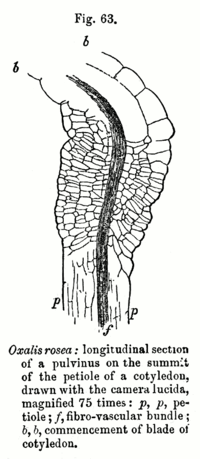Pulvinus
A pulvinus (pl. pulvini) is a joint-like thickening at the base of a plant leaf or leaflet that facilitates growth-independent (nyctinastic and thigmonastic) movement. Pulvini are common, for example, in members of the bean family Fabaceae (Leguminosae)[1]:185 and the prayer plant family Marantaceae.[1]:381

Pulvini may be present at the base or apex of the petiole or where the leaflets of a compound leaf are inserted into the rachis. They consist of a core of vascular tissue within a flexible, bulky cylinder of thin-walled parenchyma cells. A pulvinus is also sometimes called a geniculum.
Pulvinar movement is caused by changes in turgor pressure leading to a contraction or expansion of the parenchyma tissue. The response is initiated when sucrose is unloaded from the phloem into the apoplast. The increased sugar concentration in the apoplast decreases the water potential and triggers the efflux of potassium ions from the surrounding cells. This is followed by an efflux of water, resulting in a sudden change of turgor pressure in the cells of the pulvinus. Aquaporins on the vacuole membrane of pulvini allow for the efflux of water that contributes to the change in turgor pressure. The process is similar to the mechanism of stomatal closure.
Common examples for pulvinar movements include the night closure movement of legume leaves and the touch response of the sensitive plant (Mimosa pudica). Nyctinastic movements (sleep movements) are controlled by the circadian clock and light signal transduction through phytochrome. Thigmonastic movements (touch response) appear to be regulated through electrical and chemical signal transduction spreading the stimulus throughout the plant.
Pulvinus in Mimosa pudica
In Mimosa pudica, the internal biological clock mediates the closing of leaflets at night and opening during day.[2] Seismonastic or rapid movement of leaves is triggered in response touch and temperature.[3]
The pulvinus is located at the base of each leaflet of the plant. Mechanical stimulation via touch is perceived and is translated to electrical stimulation causing the flow of ions out of the pulvinus cells.[4] An upregulation of aquaporin and H+ - ATPase allows for the rapid flux of water out of these motor cells.[5] Water flux out of the cells results in a decrease in turgor pressure, and the characteristic closing of the leaves of Mimosa pudica. The drop in turgor pressure is reversible but slow. Leaves slowly open to their initial position after 20 minutes of lack of stimulation.[6] It has been demonstrated that seismonastic movement can be inhibited with the use of anesthetics.[7][8]
Using nuclear magnetic resonance, upward movement of water within the pulvinus joint in response to electrical stimulation was observed in the pulvinus at the base of the petiole.[9] Movement of water to the upper or lower part of the pulvinus causes asymmetric swelling [9] therefore causing the petiole to either droop or rise and contributing to the characteristic displacement of the petioles. The transmittance of internal electrical and chemical signals cause changes in the pulvinus which allows M. pudica to respond accordingly to touch stimuli.
References
- Heywood, V.H.; Brummitt, R.K.; Culham, A.; Seberg, O., O. (2007). Flowering plant families of the world. New York: Firefly Books. ISBN 9781554072064.
- Ueda, Minoru; Yamamura, Shosuke (9 April 1999). "Leaf-closing substance of Mimosa pudica L.; chemical studies on another leaf-movement of mimosa II". Tetrahedron Letters. 40 (15): 2981–2984. doi:10.1016/s0040-4039(99)00342-1. ISSN 0040-4039.
- Ahmad, Hafsa; Sehgal, Sakshi; Mishra, Anurag; Gupta, Rajiv (23 August 2012). "Mimosa pudica L. (Laajvanti): An overview". Pharmacognosy Reviews. 6 (12): 115–124. doi:10.4103/0973-7847.99945. PMC 3459453. PMID 23055637.
- Volkov, Alexander G; Foster, Justin C; Markin, Vladislav S (1 July 2010). "Molecular electronics in pinnae of Mimosa pudica". Plant Signaling & Behavior. 5 (7): 826–831. doi:10.4161/psb.5.7.11569. PMC 3115031. PMID 20448476.
- Fleurat-Lessard, P.; Frangne, N.; Maeshima, M.; Ratajczak, R.; Bonnemain, J. L.; Martinoia, E. (1 July 1997). "Increased Expression of Vacuolar Aquaporin and H+-ATPase Related to Motor Cell Function in Mimosa pudica L". Plant Physiology. 114 (3): 827–834. doi:10.1104/pp.114.3.827. ISSN 0032-0889. PMC 158368. PMID 12223745.
- Volkov, Alexander G.; Foster, Justin C.; Baker, Kara D.; Markin, Vladislav S. (28 October 2014). "Mechanical and electrical anisotropy in pulvini". Plant Signaling & Behavior. 5 (10): 1211–1221. doi:10.4161/psb.5.10.12658. PMC 3115350. PMID 20855975.
- De Luccia, Thiago Paes de Barros (September 2012). "Mimosa pudica, Dionaea muscipula and anesthetics". Plant Signaling & Behavior. 7 (9): 1163–1167. doi:10.4161/psb.21000. ISSN 1559-2324. PMC 3489652. PMID 22899087.
- Milne, Avaleigh; Beamish, Travis (19 December 1998). "Inhalational and local anaesthetics reduce tactile and thermal responses in mimosa pudica". Canadian Journal of Anesthesia. 46 (3): 287–289. doi:10.1007/BF03012612. PMID 10210057.
- Volkov, Alexander G.; Foster, Justin C.; Baker, Kara D.; Markin, Vladislav S. (1 October 2010). "Mechanical and electrical ansiotropy in Mimosa pudica pulvini". Plant Signaling & Behavior. 5 (10): 1211–1221. doi:10.4161/psb.5.10.12658. PMC 3115350. PMID 20855975.
Further reading
- P.H. Raven, R.F. Evert, S.E. Eichhorn (2005): Biology of Plants, 7th Edition, W.H. Freeman and Company Publishers, New York, ISBN 0-7167-1007-2